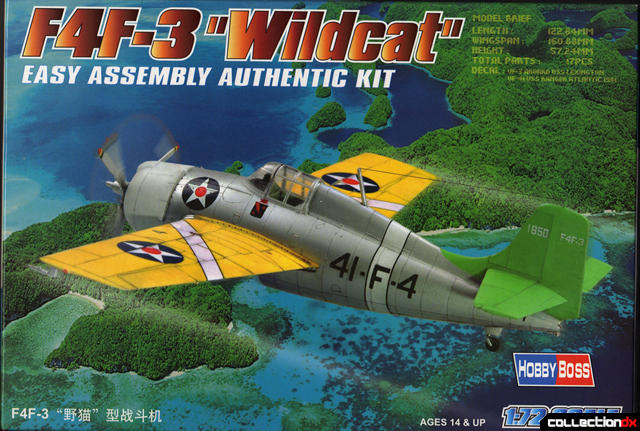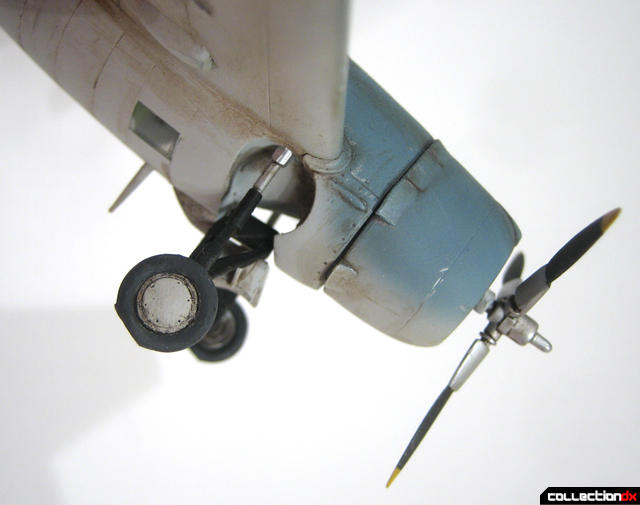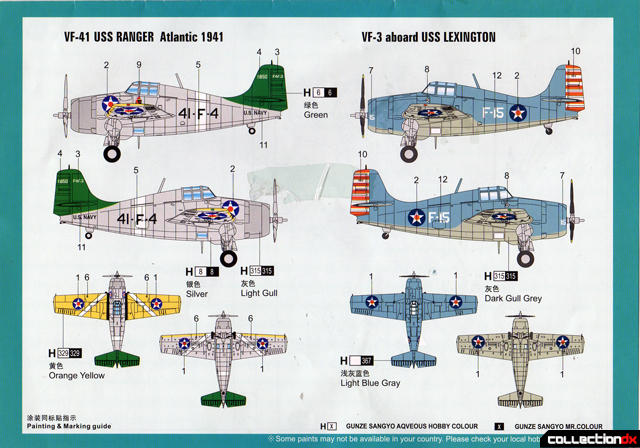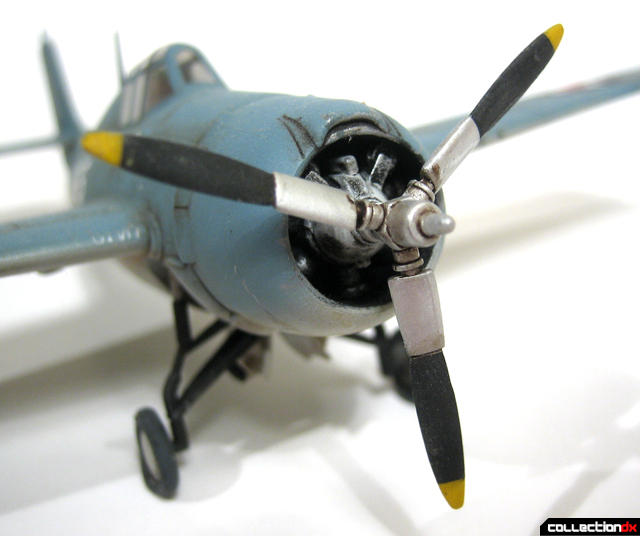Grumman F4F-3 Wildcat ENS Gayle Hermann "Pearl Harbor Dec 7th 1941"

Review by Showapop
On the morning of December 7th 1941 the United States Sailors, Marines and Army soldiers stationed at Pearl Harbor were completely unaware how their lives were going to change for the next four years. This is the story of one aviator named ENS Gayle Hermann and his F4F-3 Wildcat and his miracle crash landing at a golf course after being shot down by friendly fire on the evening of December 7th 1941.
When the Japanese IJN attacked Pearl Harbor that fateful morning their main targets were the battleship’s in Battleship Row and our Pacific aircraft carrier fleet, most notable the USS Enterprise (CV-6). Luckily for most of the crew of USS Enterprise, they were out to sea on maneuvers that morning. When they were notified of the attack, the USS Enterprise command ordered fighter (VF-6), scout (VS-6) and Bomber (VB-6) planes from their onboard flight wing to locate the Japanese fleet.

ENS Gayle Hermann was a pilot from VF-6 and was born in New Britain, Connecticut and a Duke University Graduate. ENS Hermann later enlisted in to the USN and after graduation from Pensacola in 1939 he reported to VF-6 and was stationed aboard the USS Enterprise when the IJN attacked Pearl Harbor. He was 26 years old at the time of the attack.
Six F4F-3 Wildcats (6-F-1, 6-F-15, 6-F-5, 6-F-12, 6-F-4) took off from the USS Enterprise with ENS Hermann in plane 3-F-15. Later in the evening, they were directed to land at Ford Island, as the USS Enterprise command did not want to light up the carrier for a night landing in fear of a IJN retaliation. Unfortunately, Ford Island was not the best choice for landing aircraft at night. Ford Island was surrounded by thousands of rightfully jittery USN and Army anti-aircraft gun placements and gunners and after the confusion of the battle, Ford Island command parked aircraft and obstacles across the runway to discourage any Japanese paratrooper and troop carrier landings on Ford Island and did not notify the command of the USS Enterprise.

What happened in the next half hour was not a pretty scene. When the six Wildcats approached Ford Island with their flaps down in slow landing speed every anti-aircraft, rifle and gun placements at Pearl Harbor lit up the sky, VF-6 did not have a chance. Right away three Wildcats were shot out of the sky (6-F-1, 6-F-15, 6-F-5), one parachuted safely from his plane (6-F-4) after it was shot out from under him, and one pilot actually managed to finally land his plane (6-F-5) at Ford Island dodging parked airplanes on the runway and stopping within inches of crashing into another parked aircraft.

ENS Hermann had a shell pass through the engine of his Wildcat and was shot up to 18 times. With no power, ENS Hermann managed to glide and crash his aircraft at a local golf course. Walking away from the accident with no injuries ENS Hermann made his way back to the Ford Island airfield. This was how WWII began for one ENS Gayle Hermann. Tragically about 5 months later on May 25th, 1942 ENS Hermann would drown in a landing accident when his F4F crashed into the sea after taking off from the USS Enterprise. Only one pilot from these 6 Wildcats would survive the war.
Hobby Boss 1/72 F4F-3 Wildcat
I like modeling both the attackers and the defenders of Pearl Harbor December 7th subjects in 1/72. While nearly every IJN airplane markings and pilots are accounted for modeling, US Navy and Army aircraft from that fateful day is a bit more difficult as pilots who were normally assigned to specific aircraft jumped into other planes and when those planes were shot up jumped in other planes after that. It has been a challenge to identify what pilot flew what aircraft that day. On the 68th anniversary of the attack on Pearl Harbor I will review Hobby Boss’ 1/72 F4F-3 Wildcat model kit redone with the markings of ENS Gayle Hermann’s Wildcat as a tribute to his memory.

The Grumman F4F-3 Wildcat started life as a redesign of the Grumman FF bi-plane and entered service as the Navy’s front line fighter aircraft in 1940. Although the Wildcat was a stubby and slow airplane compared to other fighters of the time, with the right pilot it became a dangerous weapon, sustaining huge amounts of damage in battle and taking the fight to IJN Zeros. Variations of the Wildcat would be used up through WWII and some used in National Guards through the late ’40s. Not bad for an airplane that started life as a lowly bi-plane!
The problem is that the F4F-3 has never gotten any love from model kit manufactures over the last 40 years, companies mostly opting to make the later folding wing F4F-4 or FM-1 Wildcat. The F4F-3 on the other hand has a non-folding solid wing and is armed with four .50 caliber machine guns as opposed to the F4F-4 six .30 caliber machine guns. Even when Hasagawa released their F4F-3 in the 1990’s it was released with the standard F4F-4 with instructions on how to rescribe the panel lines into a solid wing. So I was thrilled when Hobby Boss announced the released of their F4F-3. Or so I thought.

Hobby Boss of China is a relative newcomer to model kit manufacturing and whose quality can range to the over simplified to the ultra detailed but always at a great budget price. Unfortunately I was let down again when I opened the box to see a F4F-4 folding wing!
What is so frustrating is that the kit could have easily been released with the proper wing by the very nature of how the kit is manufactured. These 1/72 Hobby Boss scale aircraft are basically entry-level kits for kids as this kit is generally made up of two parts.

Hobby Boss’ 1/72 F4F-3 Wildcat comes with: 1x fuselage, 1x wing, 1x sprue, 2x clear sprue (open and closed canopy), 1x instructions, 1x decal sheet, 1x vacuum-form tray. Options include open and closed canopy and markings for two aircraft: VF-41 yellow wing, silver dope and willow green tailed markings from the USS Ranger while it was stationed in the Atlantic and VF-3 Blue-Gray markings aboard the USS Lexington from early 1942.

What is unusual about ENS Hermann’s aircraft is that it was a recent transfer from VF-3 from the USS Lexington and still had “3-0-0” markings and the Felix The Cat wing insignia painted below the cockpit. What led me to build ENS Hermann’s aircraft is that the kit comes with most of the decals needed to replicate his aircraft as it appeared on Dec 7th.
This kit is similar to resin kits, with solid plastic parts for the aircraft fuselage itself and the wing, and with minor details on a single sprue. All Hobby Boss had to do is cut a mold for the proper F4F-3 wing. Although it is a simple construction it is at a cost, most importantly the lack of detail for the interior and landing gear well. The real aircraft has a floating seat that the pilot can see through to the bottom of the aircraft out of two small windows. The cockpit is overly simplified but much cannot be seen once the canopy is in place. I suggest adding some photo-etched seat belts to round out the look of the interior.
Most of the work on this kit was spent carefully filling in the engraved panel lines with modeling putty and rescribing the wing to replicate the solid wing panel lines. I used Squadron In Action F4F Wildcat, which thankfully has the outline drawing of an F4F-3 in 1/72. I carefully cut away the bumps at the bottom of the wing and replaced them in the proper alignment for the F4F-3 wing.

This is a quick build as the kit really only consists of two parts. Some rescribing is necessary where the wing meets the body of the aircraft. One great feature is the bottom antenna is included as part of the bottom clear window components. This is a part that is consistently left off most F4F Wildcat kits and it great to see it finally included.
But then another problem arose during construction: How do you lay down the model kit if there is an antenna on the bottom and the top? Luckily, with the vacumform tray that is included with the kit the modeler can cut out a pre-scribed hole in the tray and there is a place to sit the model snugly into the tray without damaging the antenna. Thank you Hobby Boss for thinking ahead!
Other modifications was attaching a straight pitot tube and filling in two of the gun openings to the four-gun configuration of an F4F-3. The only aftermarket part I added was new tires from True Details a simple and inexpensive but effective upgrade to the plain tires that were included with the kit. Then the Wildcat was ready for paint.
By Dec 7Th 1941 the USN still had many aircraft painted in at least three different paint schemes. Yellow wing aircraft of the late 1930’s would be parked next to light gray scheme aircraft from the previous year. In Summer of 1941 all USN aircraft were ordered to be repainted in the new Navy Blue-Gray over light gray and many aircraft were still being repainted at the time of the attack.
This was the scheme that ENS Hermann’s aircraft was painted in during the attacked and is somewhat of a rare scheme as it was only used for about six months from Summer of 1941 to around February 1942 when the USN navy upgraded to larger national insignia, red and white tail rudder and removal of the VF designation from the aircraft markings.
Even today what the “real” color of Blue-Gray is still hotly debated in Military Modeling circles. Many modelers believe the most accurate Blue-Gray is acrylic Polly S’ Blue-Gray but Testors Model Master has an enamel Blue-Gray that matches Polly S’ closely but is quite rare to find, with Squadron Mail Order being the only supplier that has the color consistently in stock.

(Felix The Cat logo from Bluejacket.com)
Like previously stated above most all the decals needed to make ENS Hermann’s Wildcat is included in this kit including the quite difficult to locate Felix The Cat insignia in 1/72. I only had to add some “3’s” and a hyphen from my spare decal box to complete the “3-F-15” needed to complete the aircraft. I glossed the aircraft with Testors Gloss and applied the decals which went on great.
After spraying a flat coat over the decals I used oil paints to replicate the panel lines and painted the tires with Tamiya German Grey and the landing struts black.
Besides the lack of interior and wheel well details the outline of this aircraft is excellent, refined and sharp and actually builds up into a beautiful model kit. With Hasagawa’s F4F out of production and Academy’s F4F out of shape this is the best buy for making a F4F at the moment but keep in mind a lot of time was spent rescribing a wing that should have easily been released with the kit in the first place. I can look past the lack of details in the cockpit but to advertise a kit as an F4F-3 and not get one in the box was very disappointing. I still do highly suggest this kit as it builds into a beautiful kit representing one of the near lost stories of ENS Gayle Hermann’s evening at Pearl Harbor on December 7Th 1941.
For more information on the crew of V6 from the USS Enterprise on Dec 7th read Steady Nerves and Stout Hearts by Robert J Cressman and J Michael Wenger, which is where I got the picture of ENS Hermann from.
©2009 Article & Photos by Leonardo Flores and CollectionDX except ENS Gayle Hermann’s photo from Steady Nerves and Stout Hearts by Robert J Cressman and J Michael Wenger.
Comments
9 comments postedIf anyone cares for my opinion, I'm OK with such a review once in a while. It shows a fine, really nice looking model. And as Josh mentioned, it's a japanese model kit. CDX accepts model kits, as Gundams and SRW show. Hell, we even accept Lego and Mega Bloks, which also produce a variety of "real-themed" items. Just because you don't see them that much around doesn't mean they would be banned, because, let's face it, they are still toys, and as far as I can tell, CDX IS about toys :)
While model classic planes aren't my cup of tea, I think they're very much in the "spirit" of Collection DX. I however admit that the review should probably just focus on the model itself and a little less on the history of the aircraft and those who flew it.
[enthusiast pantomimes shooting himself in the head] Good review, Leo. I like learning new things, and the model's a beaut.
You should see my uncle, he's making such things (and cars, tanks, etc) from PAPER. And you can't even tell without touching it :D I need to convince him to give me some for gallery purpose :)
My friend at work loves paper models, and every week he's always showing me some great Gundam, Miyazaki or Sci-Fi paper models. I agree... amazing stuff!!!
Leonardo Flores
CollectionDX Staff Writer-West Coast Bureau
Just a touch of pedantry, the guns aren't "50mm" or "30mm" but ".30 calibre" or ".50 calibre". .30 calibre is a World war II rifle bullet, 50mm would be about an early war tank gun! (later in the war, some aircraft did use guns of that size, mostly in the anti-tank or anti-bomber role).
Yikes! I know better than that! Thanks for pointing that out, metric must be on my mind! LOL
LF
Leonardo Flores
CollectionDX Staff Writer-West Coast Bureau
Definitely an interesting review Mod! I can really tell you have a passion for this stuff and it's fascinating to read. I've always wanted to get into military model kits but I just don't have the patience or the still to pretty them up very well. I'll just have to stick with model kits it seems...
And I for one am all for reviews that are out of the flow of what's reviewed on this site. It's still a toy, and it's clear that there's the same amount of passion in the subject that let's say I have for anything that's from Super Robot Wars.
is this a comment record,
I got like 2 last thing i did...even bad comments are better than nothing...guess I have to do a model...maybe the Japanese Yamato model by aoshima...also Like Nekro dave's idea. when we write something, we tell Josh it is ready and he posts at set intervals. Would not bother me to have an article wait to be posted and would be cool to not see it on page 2 a day later...